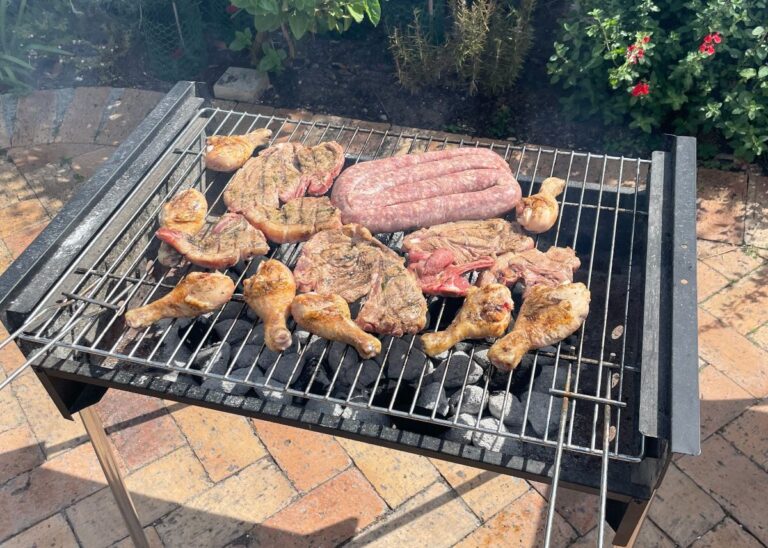Next Tuesday is Heritage Day – or as it’s affectionately become known as – “Braai Day.” But the question often arises each year: Can the braai be considered South Africa’s official food tradition?
Mzansi’s complex and rich history means that her fare reflects flavours from Europe, Asia, as well as indigenous communities. The result is a menu that is as diverse as it is tasty. Below are common foods and food traditions that are uniquely South African and likely to come out on Heritage Day.
The ‘Braai’ or ‘Shisa Nyama’
Meat is a South African staple. Essentially a braai is South Africa’s version of a barbeque but the food is traditionally cooked over wood and coals, adding to the flavour.
The meat is usually accompanied by drinks, snacks, salads and desserts. The word braai comes from the Dutch word for ‘grilled meat’. There is a Zulu term for the tradition, namely shisa nyama, that differs in its origins.
Shisa nyama started in townships as a way for butcheries to boost weekend sales. This “bring and braai” tradition reflects South Africa’s warm community spirit. The ingredients of a traditional braai or shisa nyama often include the following…
This celebrated South African sausage consists of beef, mixed with either pork or lamb and a unique spice blend.
The name boerewors comes from the Afrikaans words boer (‘farmer’) and wors (‘sausage’.) Butchers will follow strict guidelines when making boerewors to ensure the traditional flavour is preserved.
The boerie roll, meanwhile, is a South African take on a hotdog. It often comes garnished with fried onions, tomato sauce and mustard.
Chakalaka is a tomato and onion relish (and traditionally includes beans, peppers, carrots and spices.) Pap, meanwhile, is made from white cornmeal. It has a similar taste to polenta, but is creamier.
These beloved braai side dishes are frequently served with meaty mains like boerewors, steaks, lamb chops or chicken pieces to creating a unique and tasty combination of flavours and textures.
Potjiekos, meaning ‘food in a pot,’ is a traditional South African slow-cooked stew made with layers of meat and vegetables in a three-legged cast iron pot over coals.
The idea is not to stir the dish while stewing, resulting in rich and varied flavours.
Traditional Cape Malay dishes
Cape Dutch heritage has had a major influence on South African cuisine. So too has Cape Malay cooking.
During colonial times, the Dutch East India company brought slaves from areas like Bengal, Java, and Malaysia to South Africa.
These groups brought their cultural cooking practices with them. There are several Cape Malay variations of popular dishes – including bobotie, sosaties (spicy meat kebabs) and curries.
Allegedly, the Dutch recorded the first bobotie recipe in 1609. The Cape Malay community have spiced it up to what it is today.
Bobotie consists of minced meat combined with curry spices, onions, and milk-soaked bread, topped with an egg and milk mixture. Once baked it is typically served with yellow rice and fruit chutney,
This curry honours traditional Malaysian cooking methods and combines sweet and savoury flavours. It is usually served with roti and/ or yellow rice.
Aromatic spices like tumeric, Masala, cumin and cardamon are combined with sweeter elements like ginger and apricots.
A Malay curry is made with beef, chicken or lamb. It differs further from Indian curries with the addition of seasonal Cape fruit.
The Indian Bunny Chow
This is classic and traditional street food in South Africa with an Indian twist. A ‘bunny’ is a hollowed-out (quarter or half) loaf of bread filled with curry.
Its origins date back to when indentured Indian labourers in KwaZulu-Natal wanted to quickly combine their food together to take out onto the sugar-cane plantations.
Traditional snacks and sweets
Biltong and droëwors are also likely to make an appearance on Heritage Day. These traditional dried-meat South African snacks are popular across the board and have earned themselves international appeal.
When it comes to desserts, honourable mentions need to go to the traditionally-South African melktert and malva pudding. Another local favourite is the syrupy koeksister and the Cape Malay variant, the koesister.
What does Heritage Day mean to you when it comes to food?
Let us know by clicking on the comment tab below this article or by emailing info@thesouthafrican.com or sending a WhatsApp to 060 011 021 1.
You can also follow @TheSAnews on X and The South African on Facebook for the latest news.

